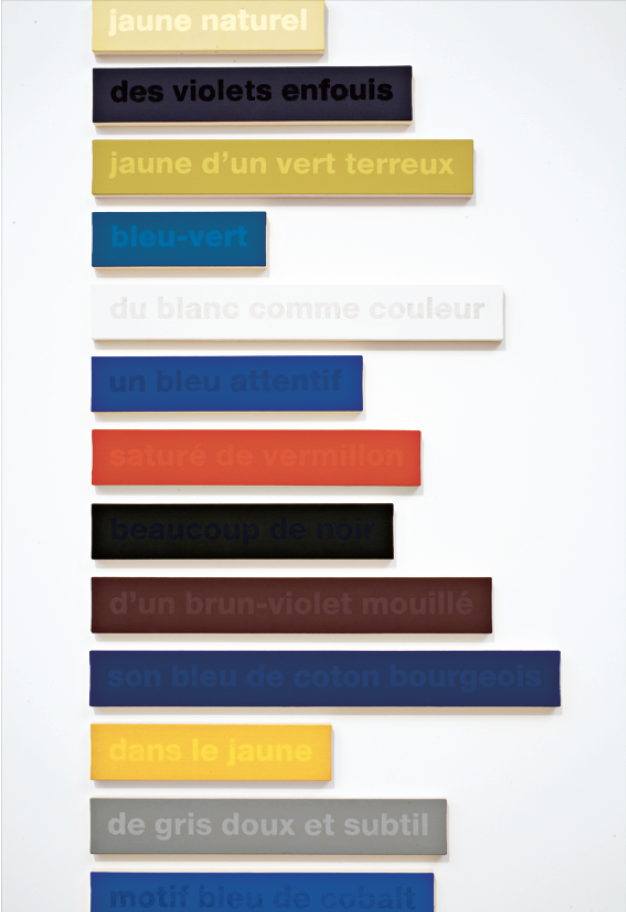Francine Savard

Francine Savard, The Colours of Cézanne in the Words of Rilke 36/100 – Test (detail), 1998, vinyl and acrylic on canvas mounted on fibreboard, framed book, 380 x 66 cm (painting), 42 x 33 cm (framed book). Photo by: Richard-Max Tremblay. Courtesy of MACM.
In Sudoku, numbers on a grid must not repeat; in crosswords, clues uncover precise words in a kind of shell game made of language. Pastimes such as these—koanlike mental exercises conducted privately in routine spaces—come to mind when seeing the retrospective of Quebec painter and graphic artist Francine Savard. With 60 pieces on view, made between 1992 and today, this sharply drawn survey follows the artist’s extended meditation on language in works that consistently catch, then direct, the eye elsewhere.
A favorite piece, for instance, is Casier pour object du désir, 2000. Beyond the poetics of the title, Casier is emblematic for its love of paradox and fascination with the sign as problematic: stand-in, shadow, shell game. A large box-like structure made of thin strips of wood arranged in a modified grid, Casier recalls an embellished canvas stretcher or a Mondrian painting. It’s a disciplined arrangement of squares and rectangles, a tidy stack of window frames offering views into pure space and a glimpse of desire’s elusive nature. The work stands off-centre in the first of four gallery rooms devoted to Savard and faces off against another from the same period: Ensemble sans titre, 1998, a large tube covered with canvas, drizzled with white paint and placed on a low wooden plinth.

Francine Savard, The Colours of Cézanne in the Words of Rilke 36/100 – Test, 1998, vinyl and acrylic on canvas mounted on fibreboard, framed book, 380 x 66 cm (painting), 42 x 33 cm (framed book). Photo by: Richard-Max Tremblay. Courtesy of MACM.
Together and as discrete objects, these two works neatly connect the dots between sculpture and the act of painting, between the three-dimensional figurative world and abstract representation in a careful dialogue animating some of the key theoretic concerns of the last 50-odd years. Is painting dead? Can language do justice to the complexity of daily life? If the problems feel well trodden at this point, the pleasure Savard takes in such ruminations nevertheless nudges us onwards to see the merits of, and partake in, the quiet readings and private labours beckoned here and elsewhere. For example, a studious riff on the artist Fernand Leduc plays with the limits of language and, by extension, art itself. Five paintings, the canvases borrowing iconic shapes from Leduc, are strewn across a single wall, each presenting a colour and a phrase used to describe his art: Une étendue jaune, 2001, or Un pan orange, 2001. Mind the gap, the artist seems to say: between past and present, word and object, surface and some other equally elusive expressive terrain.
Elsewhere, in a separate room, Savard assigns eight different functions to words—for example, naming in N=32% or qualifying in Q=19%—and the resulting eight black-on-white paintings become a means of measuring a text visually, a kind of reverse art criticism and a marker of the anxiety to contain the unruly elements of experience through language. The cool graphic effect—think punch cards or pixels—is the product of the artist’s own idiosyncratic code making. In another series entitled Je déballe ma bibliothèque, 2007, after the essay by Walter Benjamin, five irregularly shaped paintings—acrylic on canvas on wood—float like islands or city lots affixed to the wall. These take inspiration from Savard’s photographs of cardboard boxes in her studio. Here, the artist’s fusion of concrete data and mundane sources conveys a commitment to external structure and interior meaning, each to be found in the banal corners of quotidian life.
Countering any sense of the abstract as universal, and what I take to be a profoundly feminist eye, Savard builds, finally, a cool, even remote universe, fabricated from in-jokes, private games and cool observations about the limits of categorization. ❚
Francine Savard was exhibited at the Musée d’art contemporain in Montreal, from October 9, 2009, to January 3, 2010.
M J Thompson is a writer living in Brooklyn and Montreal.

